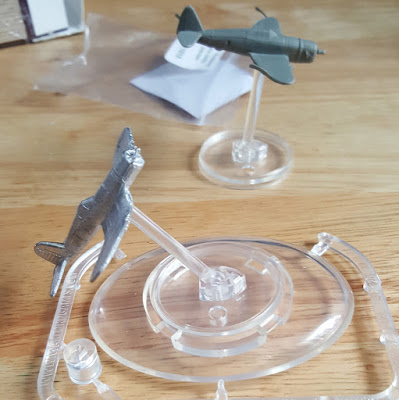I am a history nerd, and am a magpie when it comes to historical miniature games. Of course I had to get some Blood Red Skies miniatures. I grew up playing games like Hellcats Over the Pacific, and the Aces games, so I may or may not somehow have a bunch of Spitfires, a P-47, an F4F, and a Corsair. I want to address something strange I've noticed as I started to acquire miniatures for this game, and discuss subtle reasons why design (and design iteration) is so important.
In Blood Red Skies, it is very important whether or not your plane is in an "advantaged" or "disadvantaged" position. The way the game tracks this is by tilting planes nose-up or nose-down to indicate this. A plane with its nose up (climbing) is considered to be "Advantaged", whereas nose down (diving) is "Disadvantaged". Level flight is of course neither. This is the first design oddity; If you're a fan of air combat, especially in WW2, being higher up and able to dive gives a wealth of benefits such as increased speed, reduced effects of bullet drop, etc. Why then is the plane that's at the advantage depicted climbing?
 |
| Left: advantaged. Middle: Neutral. Right: Disadvantaged. |
Now, that aside, there is of course the issue of it also looking slightly absurd if an advantaged plane fights a disadvantaged plane at close range:
 |
Missed Me!
|
But there's a bigger problem. A waaay bigger problem. Some of the planes are not plastic. Some, are metal. Let's take a look at that?
Looks fine right? Should be fine if we just tilt this thing into "Advantage" position right?
Whups! Drunk Corsair time. That's not viable for gameplay at all! So already we have a huge design flaw which either forces the company to only produce plastic miniatures, or have this big flaw in your metal ones. There's a few solutions, but let's see what they went with:
If you guessed "Giant additional plastic thing" then congrats! Yep, every metal miniature comes with a larger, clear-plastic 'foot' to keep the plane off the deck. This requires a lot of extra work designing, producing, ensuring packaging fits it properly, and still leaves you with another design problem:
 |
| (Shown here with plastic minis for ease) |
I don't yet know how common something like this could be in-game, but what if two planes fly close to one another? If the original flight stand counts as the "area" of a plane rules-wise, does the increased foot count? God Forbid two such hoofed beasts come near one another...
But surely there's no other solution right? how to integrate tilting planes in a flying game?
Well, for a rare moment allow me to celebrate GW's solution to this problem:
Aeronautica Imperialis uses this fascinating flight peg with a ball top. We can debate if desired whether a base with a bunch of info is logical or not, but that little ball there is fantastic.
Behold how this simple solution slots into a spot under the plane, allowing it to both climb and dive, as well as bank left or right without great cost to overall centre of mass, balance, or model adjacency.
Also, speaking on production's side, it requires far less of it. The click-base of Blood Red Skies is at least a two part production, pre-assembled at the manufacturer, sent to the user, for further assembly. Also, because the flight stand is pre-assembled it neither ships nor stores flat, but always has that A-frame bend. Lastly, should I break a flight stand for Aeronautica, I can use a spare rod and keep flying with base and plane intact, whereas Blood Red Skies risks a breakage requiring me to buy more (or repair it, since I'm not certain if they're sold separately.)
It is a cautionary tale that I am sure has cost loads more money in production and planning than a bit more design iteration time and a cleaner solution would have resulted in.
Thus ends the public broadcast, hopefully I'll be back with more cool models and conversions soon!










No comments:
Post a Comment